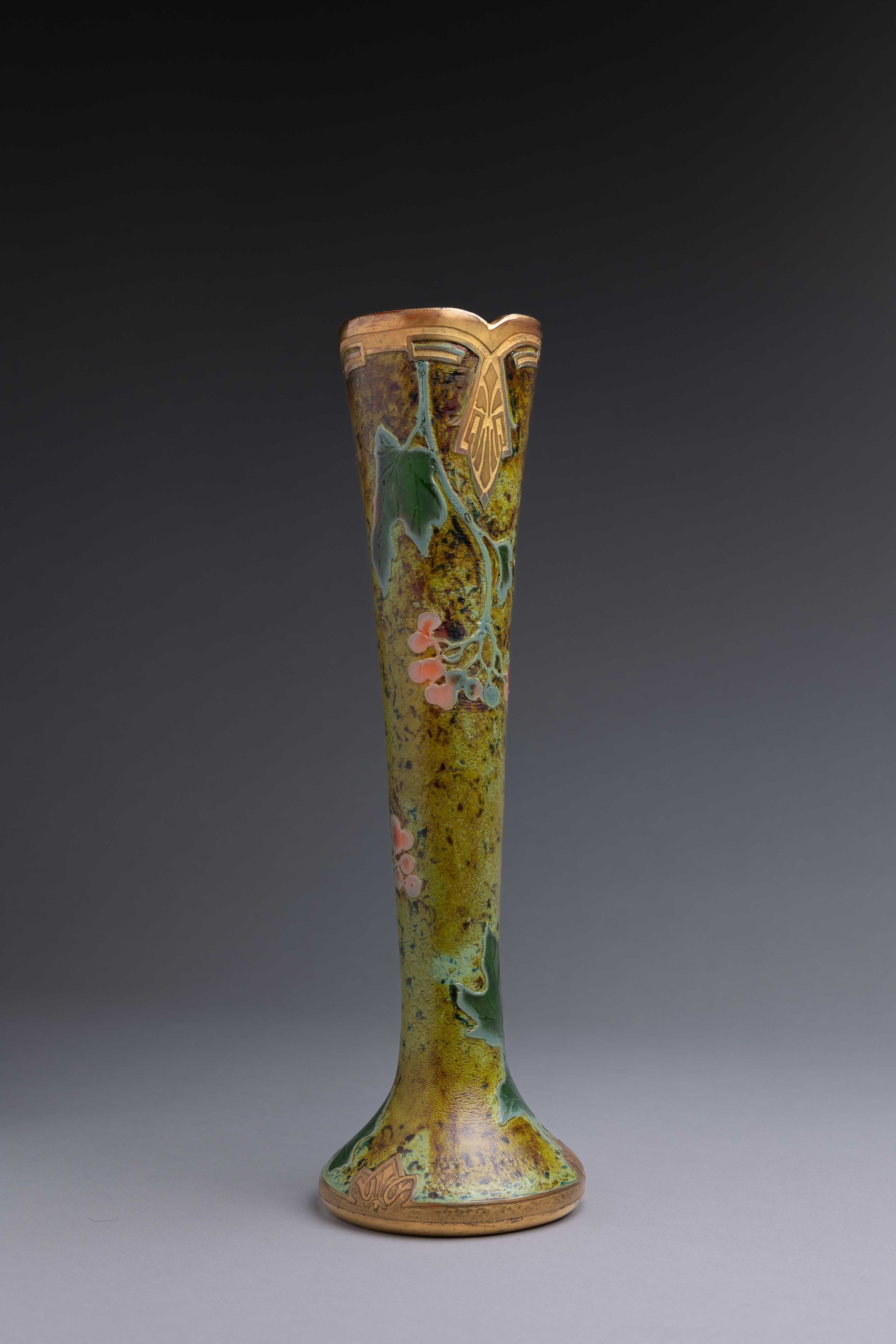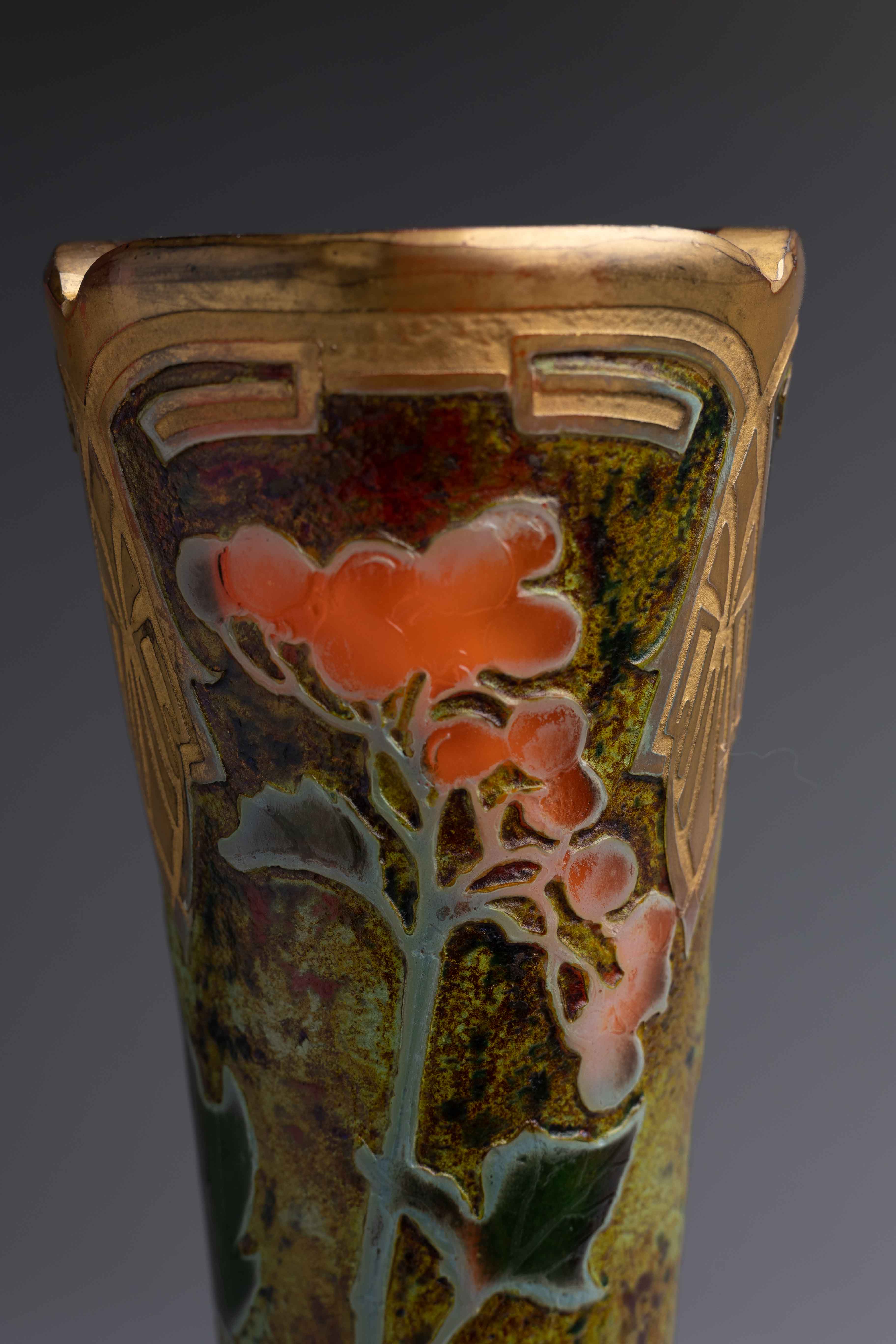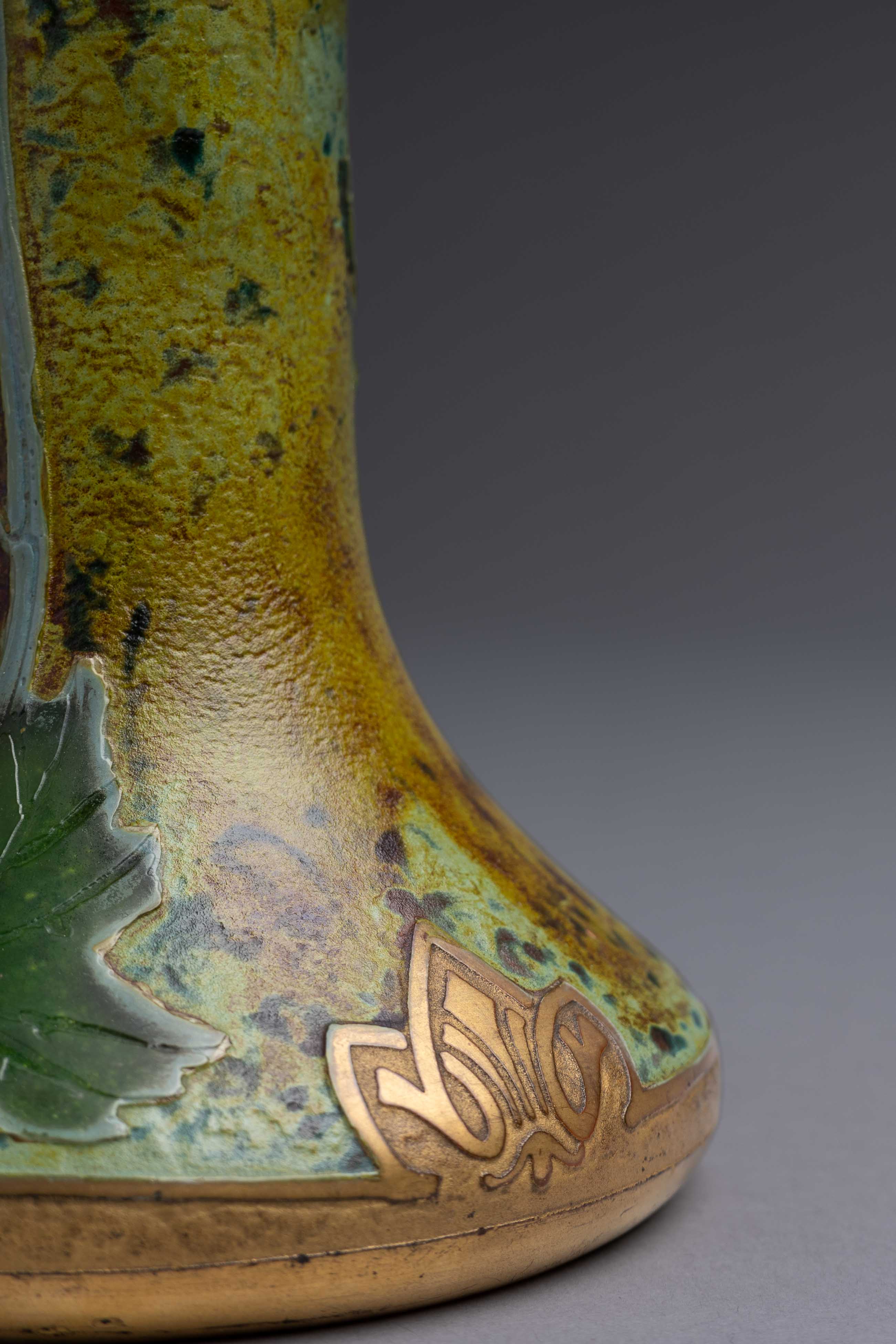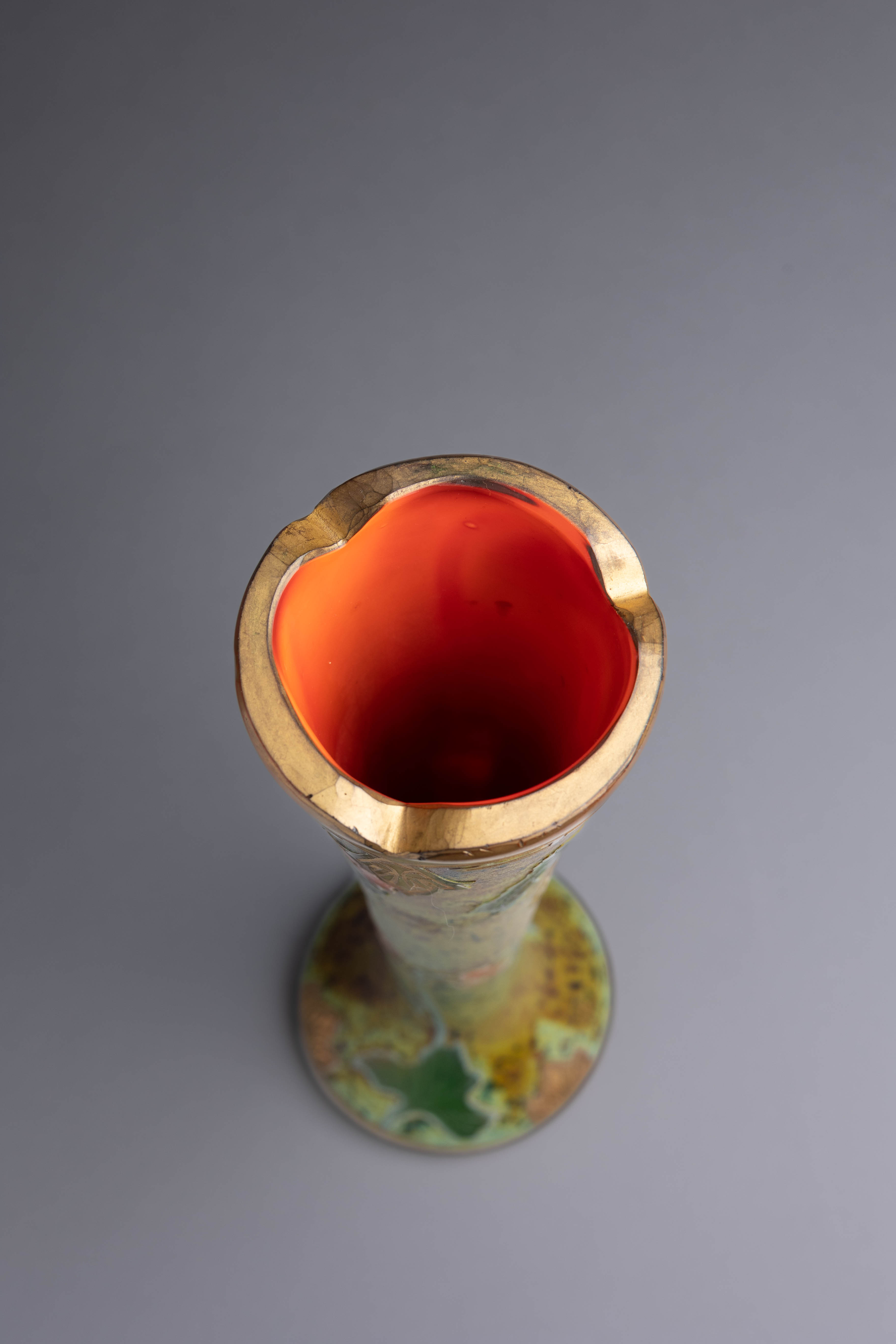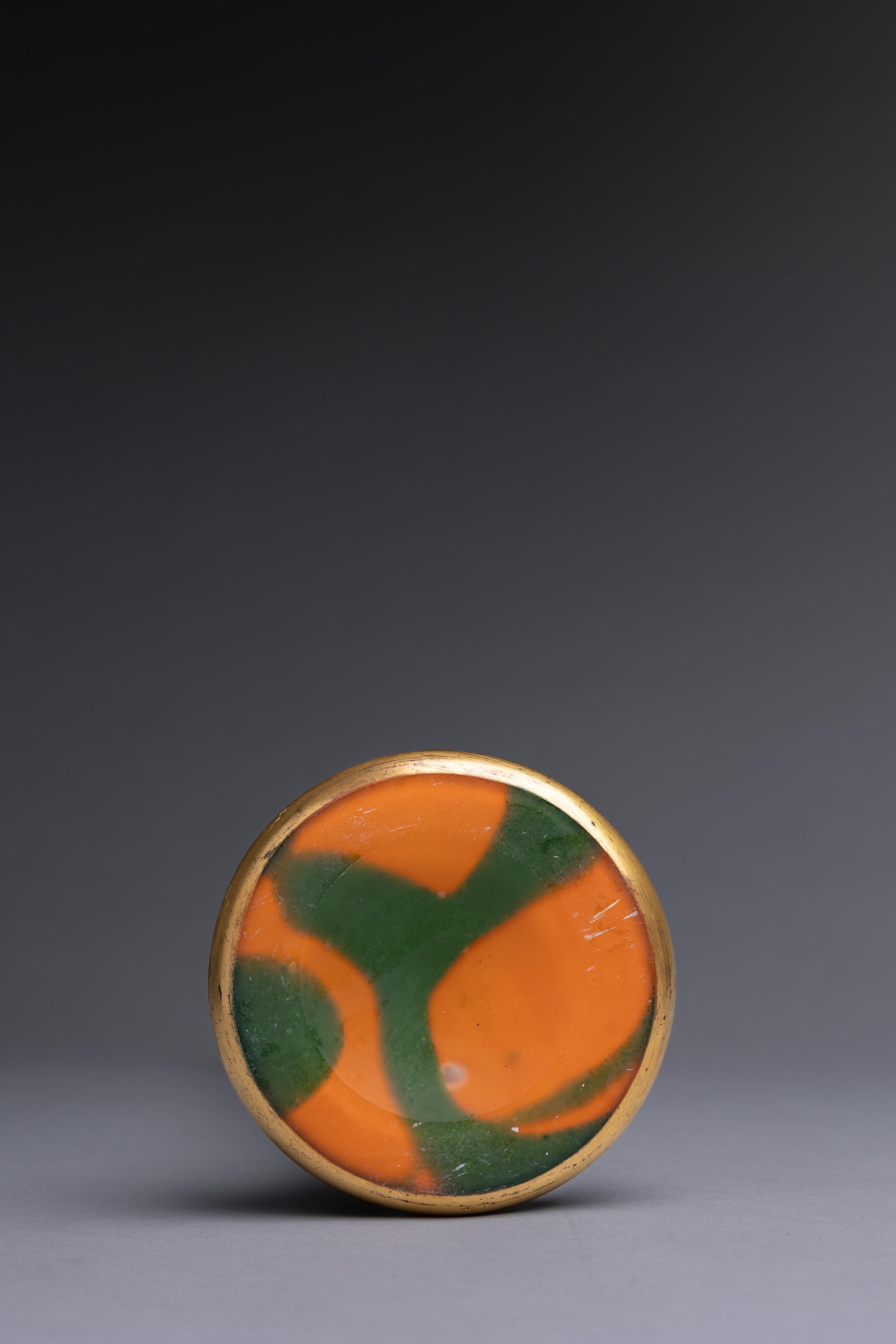France became the center for art glass production in the early 20th century, with names such as Gallé, Daum, and Lalique dominating the market at home and abroad. Among their ranks was François-Théodore Legras, whose glasswares contributed to the refinement of Art Nouveau glass in Europe. This vase, from Legras’s ‘Indiana’ line, exemplifies Art Nouveau design with its abstracted, natural forms and curvilinear details.
France became the center for art glass production in the early 20th century, with names such as Gallé, Daum, and Lalique dominating the market at home and abroad. Among their ranks was François-Théodore Legras, whose glasswares contributed to the refinement of Art Nouveau glass in Europe. This vase, from Legras’s ‘Indiana’ line, exemplifies Art Nouveau design with its abstracted, natural forms and curvilinear details.
Essay
At the turn of the century, the Art Nouveau style began to appear in Europe, with asymmetrical designs of abstracted shapes alongside organic, nature-inspired forms. The influence of historical French styles, such as Rococo, can be seen in some designs, although the movement sought to be ahistorical in its creation of an original “new art.” Additionally, japonisme’s popularity carried over from the Aesthetic Movement into Art Nouveau styles, providing inspiration for artists to create designs incorporating influences from non-European cultures.
The term “art nouveau” comes from the name of a Parisian shop called “Maison l’art nouveau,” opened in 1895 by art dealer Siegfried Bing. Bing believed that France’s mass-produced art objects were declining in quality and sought to create a new national style for the decorative arts. After years of collecting and research, including travels to Japan, Brussels, and the United States, Bing returned to Paris to open up his shop filled with the works of up-and-coming artists and designers. Bing also exhibited in the 1900 Paris Exposition Universelle, and on that global stage Art Nouveau entered popular culture. The style soon infiltrated art, architecture, and fashion on both sides of the Atlantic.
Alongside the advent of the Art Nouveau Movement, France became the center for art glass production in the early 20th century, with names such as Gallé, Daum, and Lalique dominating the market at home and abroad. French verriers introduced many new techniques and designs to glassmaking, and were quick to incorporate the highly popular Art Nouveau style into their wares. Among their ranks was François-Théodore Legras, whose glasswares contributed to the refinement of Art Nouveau glass in Europe.
François-Théodore Legras founded his eponymous glass manufactory in 1864. While most of the major glass factories were based in the Nancy region of France, Legras et Cie was the largest glass manufactory in the Paris area, located in Saint-Denis and employing over 1,200 workers. Legras utilized similar glassmaking techniques as those used by Gallé, but the manufactory’s wares were targeted for middle-class consumption. As explained by Philippe Olland, Legras’s goal was “to produce pieces of taste cheaply, to popularize, so to speak, artistic productions by putting them within the reach of the humble through modesty of their prices, in short, to produce luxury items at the best price” (Olland 203).
This tall, elegant glass vase comes from the ‘Indiana’ line produced by Legras in the beginning of the 20th century. It is a fine example of French Art Nouveau design. Legras et Cie introduced the ‘Indiana’ series around 1900, when the Art Nouveau Movement was at the height of its novelty. Most pieces from the series feature large poppies; this one is a rarer variant, much more restrained in its design with delicate berry sprigs curving around the slender vase. The red berries, rendered in cameo glass, stand out against an acid-etched ground of mottled green. Rendered rather graphically, japonisme’s influence can certainly be seen in these flowers’ flat forms. The vase’s opening and base are accented with gilded curvilinear details that are decidedly Art Nouveau.
The popularity of Art Nouveau lasted well into the initial years of the 20th century. However, due to the high demand for the style, the quality of these art objects declined, reverting back to what Art Nouveau and Siegfried Bing sought to remedy in the first place. The First World War put an end cap on Art Nouveau when artistic industrial production as a whole slowed to focus on the war effort. When it returned, a more modern Art Déco style prevailed.
BT
Condition
Excellent.
For a detailed condition report, please contact us.
References
Museum of Arts and Applied Sciences, NSW, A8000
Literature
Philippe Olland, Dictionnaire des maîtres verriers: marques & signatures de l’Art nouveau à l’Art déco (Quetigny: Faton Editions, 2016). Similar model illus. pg. 203.
At the turn of the century, the Art Nouveau style began to appear in Europe, with asymmetrical designs of abstracted shapes alongside organic, nature-inspired forms. The influence of historical French styles, such as Rococo, can be seen in some designs, although the movement sought to be ahistorical in its creation of an original “new art.” Additionally, japonisme’s popularity carried over from the Aesthetic Movement into Art Nouveau styles, providing inspiration for artists to create designs incorporating influences from non-European cultures.
The term “art nouveau” comes from the name of a Parisian shop called “Maison l’art nouveau,” opened in 1895 by art dealer Siegfried Bing. Bing believed that France’s mass-produced art objects were declining in quality and sought to create a new national style for the decorative arts. After years of collecting and research, including travels to Japan, Brussels, and the United States, Bing returned to Paris to open up his shop filled with the works of up-and-coming artists and designers. Bing also exhibited in the 1900 Paris Exposition Universelle, and on that global stage Art Nouveau entered popular culture. The style soon infiltrated art, architecture, and fashion on both sides of the Atlantic.
Alongside the advent of the Art Nouveau Movement, France became the center for art glass production in the early 20th century, with names such as Gallé, Daum, and Lalique dominating the market at home and abroad. French verriers introduced many new techniques and designs to glassmaking, and were quick to incorporate the highly popular Art Nouveau style into their wares. Among their ranks was François-Théodore Legras, whose glasswares contributed to the refinement of Art Nouveau glass in Europe.
François-Théodore Legras founded his eponymous glass manufactory in 1864. While most of the major glass factories were based in the Nancy region of France, Legras et Cie was the largest glass manufactory in the Paris area, located in Saint-Denis and employing over 1,200 workers. Legras utilized similar glassmaking techniques as those used by Gallé, but the manufactory’s wares were targeted for middle-class consumption. As explained by Philippe Olland, Legras’s goal was “to produce pieces of taste cheaply, to popularize, so to speak, artistic productions by putting them within the reach of the humble through modesty of their prices, in short, to produce luxury items at the best price” (Olland 203).
This tall, elegant glass vase comes from the ‘Indiana’ line produced by Legras in the beginning of the 20th century. It is a fine example of French Art Nouveau design. Legras et Cie introduced the ‘Indiana’ series around 1900, when the Art Nouveau Movement was at the height of its novelty. Most pieces from the series feature large poppies; this one is a rarer variant, much more restrained in its design with delicate berry sprigs curving around the slender vase. The red berries, rendered in cameo glass, stand out against an acid-etched ground of mottled green. Rendered rather graphically, japonisme’s influence can certainly be seen in these flowers’ flat forms. The vase’s opening and base are accented with gilded curvilinear details that are decidedly Art Nouveau.
The popularity of Art Nouveau lasted well into the initial years of the 20th century. However, due to the high demand for the style, the quality of these art objects declined, reverting back to what Art Nouveau and Siegfried Bing sought to remedy in the first place. The First World War put an end cap on Art Nouveau when artistic industrial production as a whole slowed to focus on the war effort. When it returned, a more modern Art Déco style prevailed.
BT
Excellent.
For a detailed condition report, please contact us.
Museum of Arts and Applied Sciences, NSW, A8000
Philippe Olland, Dictionnaire des maîtres verriers: marques & signatures de l’Art nouveau à l’Art déco (Quetigny: Faton Editions, 2016). Similar model illus. pg. 203.
This item ships free to the continental US, and globally for a flat-rate fee of $75.
All objects are packed with utmost care by our team of expert fine art shippers. All items are shipped with parcel insurance.
For more information on our shipping policies, please visit our FAQ Page.




